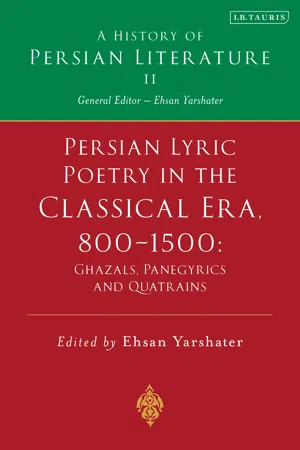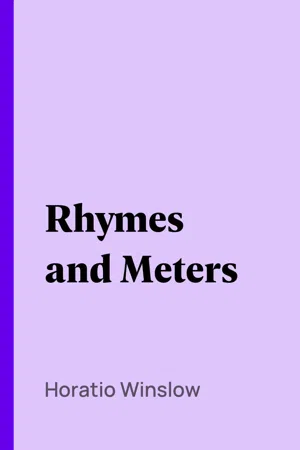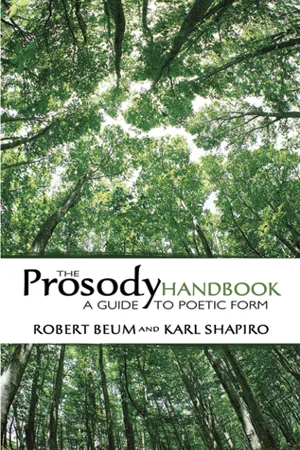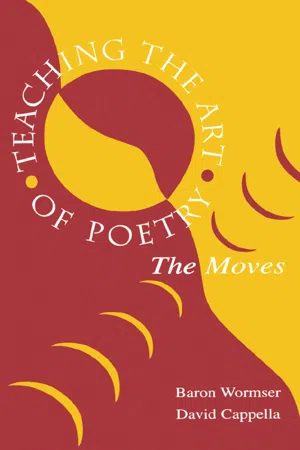Literature
Quatrain
A quatrain is a stanza in a poem that consists of four lines. It is a common form in poetry and can be found in various types of poems, including sonnets and ballads. Quatrains often follow specific rhyme schemes and are used to convey a complete thought or idea within the four lines.
Written by Perlego with AI-assistance
5 Key excerpts on "Quatrain"
- eBook - ePub
Persian Lyric Poetry in the Classical Era, 800-1500: Ghazals, Panegyrics and Quatrains
A History of Persian Literature Vol. II
- Ehsan Yarshater(Author)
- 2020(Publication Date)
- I.B. Tauris(Publisher)
927), Manjik (d. ca. 991), and Abu Shakur of Balkh (d. 947). 14 We have many more examples from the poets of the Ghaznavid and Saljuq eras. In the divans (collected works) of these poets, Quatrains are usually placed in the final pages. The Quatrain’s popularity, over more than a millennium, relates in part to its form, in which a subject is presented in a terse fashion. The first two lines usually introduce a topic, the third raises a question or presents the crux, and the last line brings the resolution. As Hans de Bruijn points out, if a Quatrain is to be successful, it should “express a certain development of thought, for which in many cases the third non-rhyming line is used. It connects the initial idea or image put forward in the first two lines to a conclusion contained in the final line.” 15 To illustrate this structure, in the first two lines of the following Quatrain the poet invites us to imagine ourselves as Solomon’s son, having his proverbial power of being carried on his throne by the wind wherever he likes - eBook - ePub
Rhymes and Meters
A Practical Manual for Versifiers
- Horatio Winslow(Author)
- 2009(Publication Date)
- Perlego(Publisher)
In the seventeenth century the Quatrain was a favorite tool of the old English writers who wished to embody a stinging epigram or epitaph in verse. The works of Robert Herrick contain several, most of them, unfortunately, not fit for print. Nor was he the only unblushing exponent of the questionable Quatrain.But times have changed and like everything else the Quatrain has grown respectable. From the disuse and misuse into which it had fallen the modern magazine editor rescued it and by creating a market revived the art of Quatrain making. To-day sometimes the four lines are descriptive; again they contain a kindly or clever epigram, or perhaps an unexpected twist at the end that makes for a joke.The average Quatrain is in iambic pentameter with alternate lines rhyming. Sometimes the first and fourth lines rhyme and the second and third, and occasionally one sees a detached Omaric stanza. It all depends upon the thought and the way it is to be expressed. One thing is certain, that the Quatrain because of its very brevity demands more care and polishing than a longer piece of verse. The thought must not only be concise and clearly expressed but the four lines must contain nothing else.The following example by Frank Dempster Sherman not only describes this form of verse but is an excellent Quatrain in itself:“Hark at the lips of this pink whorl of shell And you shall hear the ocean’s surge and roar: So in the Quatrain’s measure, written well A thousand lines shall all be sung in four.”The SonnetIt is the ambition of many a versifier to be known as a maker of sonnets. Doubtless this love for the form is prompted not only by its possibilities but even more by its traditions. Shakespeare, Milton, Wordsworth and Rossetti, to mention only a few of the celebrated names, were masters of the sonnet, though it must be said that the version used by the earlier English writers was not the one we know to-day. Shakespeare’s seventy-third sonnet may serve as a fair example of the arrangement of the lines in the early Elizabethan period, though even in his day the present rhyming order was passing gradually into use. - eBook - ePub
The Prosody Handbook
A Guide to Poetic Form
- Robert Beum, Karl Shapiro(Authors)
- 2012(Publication Date)
- Dover Publications(Publisher)
Triplets are relatively rare in English, and there are no first-rate triplet poems of any considerable length. It is difficult to find sufficient rhyme, and difficult to endure such intense rhyming for more than a few stanzas. The Augustan poets sometimes allowed triplets in their heroic couplet poems, especially when an effect of expansion or intensification was desired. Robert Bridges’ octosyllabic couplet poem “Eros” ends with a triplet that is strikingly effective by contrast.EXAMPLESterza rima SHELLEY, Ode to the West Wind; BROWNING, The Statue and the Bust triplets GEORGE HERBERT, Paradise; ROBERT HERRICK, Upon Julia’s Clothes III. QuatrainS
The favorite English verse form is the Quatrain, a stanza of four lines. Eight types of Quatrains are fairly common: (1) the ballad stanza, (2) the long ballad, (3) the short ballad, (4) the heroic Quatrain, (5) the Rubaiyat stanza, (6) the In Memoriam stanza, (7) the brace stanza, and (8) the unrhymed Quatrain (often called a tetrastich). Ordinarily all of these are iambic, but trochaic Quatrains are not rare, and traditionally the three ballad stanzas freely admit anapests and other types of feet.There is nothing mysterious about the popularity of Quatrains. Where the rhyme is alternating, they can be constructed as a two-part structure, making balance, parallelism, and antithesis quite feasible. And they save rhyme in a rhyme-poor language. When a relatively short and self-contained stanza is required, the Quatrain is ready to hand. The interweaving, forward-pulling effects of terza rima rule out that form, and the tercet and the five-line stanza provide little opportunity for balance and antithesis. The five-line stanza (e.g., ababa; abbab; ababb) raises the problem of finding three identical rhymes, and so of course does the triplet, which has the additional disadvantage that it tends to cloy. Following are some Quatrain patterns.1. Ballad Stanza
Lines I and 3 are iambic tetrameter, 2 and 4 trimeter; rhyme schemes abab or xaxa.A slumber did my spirit seal; a I had no human fears; b She seemed a thing that could not feel a The touch of earthly years. b There lived a wife at Usher’s well, x And a wealthy wife was she; a She had three stout and stalwart sons, x And sent them o’er the sea. a 2. Long Ballad
- eBook - ePub
Teaching the Art of Poetry
The Moves
- Baron Wormser, A. David Cappella(Authors)
- 1999(Publication Date)
- Routledge(Publisher)
As it offers more possibilities for rhyme, the Quatrain is more strongly rooted in rhyme than the couplet and tercet (a rhymed three-line stanza such as the blues stanza). The editors of Strong Measures: Contemporary American Poetry in Traditional Forms distinguish among seven sorts of Quatrains, to say nothing of the ballad and eight-line forms (“octaves”) that are in effect double Quatrains. The most common rhyme schemes are abab, aabb, and abba. What the poet gains from the rhymed Quatrain is a blend of discursiveness and pointedness. The frame of the Quatrain is ampler than the couplet or tercet and allows for more material to be incorporated. On the other hand, the rhyme scheme keeps creating associations as various end words rhyme. Al Young’s poem “Lester Leaps In” about the great saxophonist Lester Young is included in the Strong Measures anthology. Here is the final Quatrain: Here lived a man so hard and softspoken he had to be cool enough to hold his horn at angles as sharp as he was heartbroken in order to blow what it’s like being born. Young makes strong use of the Quatrain’s ability to construct and hammer home definitions. The stanza is an epitaph as it concisely presents the sum of an artist’s life. The Quatrain’s rhyme scheme of abab is a powerful reinforcer as the rhyming words highlight the poem’s themes. Within one Quatrain and one sentence Young makes a poetically irrefutable statement. With its balances and antitheses the Quatrain is a species of logic. Contemporary masters of the Quatrain such as Richard Wilbur and X.J.Kennedy deploy all the standard rhyme schemes and come up with their own variations - eBook - ePub
Verse
An Introduction to Prosody
- Charles O. Hartman(Author)
- 2015(Publication Date)
- Wiley-Blackwell(Publisher)
(Internal rhyme foregrounds the opposition between “reveal” and “conceal.”) The abba pattern, by joining the beginning to the end, emphasizes each stanza’s closure. This one starts with a notion of “sin” and is rounded out by “the Soul within.” In between is a tightly rhymed couplet (“feel / reveal”). At the same time, the syntax of the sentence is divided sharply after the second line. The rhyming structure is one of enfolding – the outer rhymes embrace the inner ones – while the structure of the sentence makes the last two lines feel like a reversal of the first two. Two different ideas about structure jostle against each other. Poets often use this kind of double patterning – in stanzas as in other aspects of the poem’s language – to heighten our sense that the poem is working to organize complex thought and feeling.Quatrains can even be made from pairs of couplets (aabb). Here is Percy Shelley’s poem (1824) called “To – ”:/ | x x / / | x / Music, when soft voices die, / | x (/) | x / | x (/) Vibrates in the memory – / | x x / / | x / x Odours, when sweet violets sicken, / | x / | x / | x / x Live within the sense they quicken/ | / x | x / | x / Rose leaves, when the rose is dead, x / | x (/) | x / | x / Are heaped for the beloved’s bed; x / | x / | x / | x / And so thy thoughts, when thou art gone, / | x / | x / | x (/) Love itself shall slumber on.This is the least usual rhyme scheme for the Quatrain. It has the oddly resonant effect of doubling each stage in the development of the rhyming structure. It might seem not to matter whether this poem is printed as Quatrains or as couplets, but the four-line stanza contributes to the sense of doubling: the poem is in two parts, each made of halves, each of which is a pair of rhymed lines.One of the most common Quatrain forms, the ballad stanza, is originally a song form, and we’ll see it again in Chapter 5
Index pages curate the most relevant extracts from our library of academic textbooks. They’ve been created using an in-house natural language model (NLM), each adding context and meaning to key research topics.
Explore more topic indexes
Explore more topic indexes
1 of 6
Explore more topic indexes
1 of 4




